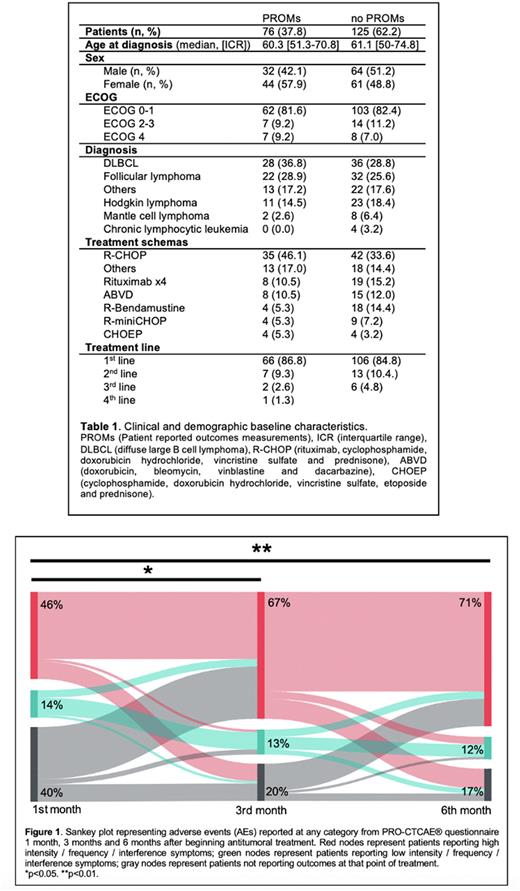Abstract
Introduction Different validated questionnaires to assess quality of life (QoL) exist and are used in clinical trials for patients with hematological malignancies. The use of Patient-Reported Outcome Measurement (PROM) in daily clinical practice is scarce. "E-Res Salud” is a value-based healthcare program implemented in a public hospitals network in Spain that aims to give voice to patients and collect individual and aggregate data to improve process management and patient journey. The hypothesis of this prospective single-center study was that the implementation of an electronic PROM (ePROM) program in patients with lymphoma receiving intravenous (iv) chemotherapy in the outpatient setting may improve self-perception of health and allow a better use of resources. The primary objective was to compare the adverse events (AEs) profile reported by physicians in the electronic medical record (EMR) and those reported by patients through a validated questionnaire (PRO-CTCAE®). Secondary objectives were to describe the evolution of symptoms reported along the treatment period and to analyze the impact of a PROM program in the reduction of visits to Emergency Room (ER) and unscheduled hospitalizations.
Methods Patients with diagnosis of non-Hodgkin lymphoma (NHL) in the need of iv. therapy between 1st January 2019 and 31st December 2021 were included in the study. "E-Res Salud” was launched in January 2020. Patients included in 2019 and those rejecting participation were considered the control arm. All participating patients were registered in the hospital patient portal. PRO-CTCAE® was electronically sent through the app at 3 points (after 1st, 3rd, and 6th month of therapy). Those reporting symptoms of low intensity were to receive recommendations automatically through the app. Those reporting symptoms of high intensity were to receive a teleconsultation call by the specialized nurse. Differences in proportions were compared with chi-square test. Survival was estimated with Kaplan Meier method. A Sankey diagram was built to depict flows of severity of symptoms. Two-sided test and p-values <0.05 were considered statistically significant. Analysis were performed with SPSS-Statistics.v.23.
Results Among the 201 patients included in the study, 76 patients (37.8%) reported outcomes in the ePROM program. Despite patients were not randomized, baseline characteristics were balanced (Table 1). Most frequently AEs reported by physicians in the EMR were hematological (73%), gastrointestinal (62%) and psychological (38%). In contrast, the most frequently patient-reported adverse events were cutaneous (47%), gastrointestinal (44%) and oral (26%), according to PRO-CTCAE® categories (p<0.01).
A Sankey diagram showed symptoms’ flow during the first six months of treatment. After the first course of chemotherapy, 46% of patients reported symptoms of high frequency, intensity or impact in their QoL. At third month the proportion of patients reporting high intensity symptoms was significantly higher (67% vs. 46%; p<0.05). No differences were found between the third and sixth month. Differences were also statistically significant between first and sixth month (p<0.01).
Finally, those who were adherent to the program had fewer number of visits to ER (19.2% vs. 55.2%; p<0.01) and required fewer unscheduled hospital admissions (15.8% vs. 37.6%; p<0.01). When analyzing outcomes of patients with symptoms of high intensity, the intervention of a specialized nurse reduced the proportion of patients who finally visited the ER vs. those who didn't report any or low intensity symptoms (18.8% vs. 53.8%; p<0.01). Overall survival among patients visiting ER was significantly shorter than among those who did not (stratified hazard ratio, 2.26; 95% confidence interval [CI], 1.11 to 4.63; p=0.025).
Conclusion Better understanding of patient-reported symptoms could aid physicians to develop an individualized treatment plan. The use of ePROM and secondarily identifying those patients who report symptoms of high intensity may be translated into a better self-perception of health and QoL. The reduction of ER visits should be a key target for hematologists as it may impact in survival. Further follow-up and larger sample size will allow us to increase data granularity of the level of detail considered in this model and will lead to a decision-making process by integrating patients voice into healthcare decision.
Disclosures
Cordoba:Takeda: Consultancy; Kite: Consultancy, Speakers Bureau; Pfizer: Research Funding; Bristol Myers Squibb: Consultancy, Honoraria; Celgene: Honoraria; Gilead: Honoraria; Janssen: Consultancy, Honoraria, Speakers Bureau; Incyte: Consultancy; GenMab: Consultancy; BeiGene: Consultancy; Lilly: Consultancy; AstraZeneca: Consultancy, Honoraria, Speakers Bureau; AbbVie: Consultancy, Honoraria, Speakers Bureau; Roche: Consultancy, Honoraria, Speakers Bureau.
Author notes
Asterisk with author names denotes non-ASH members.


This feature is available to Subscribers Only
Sign In or Create an Account Close Modal